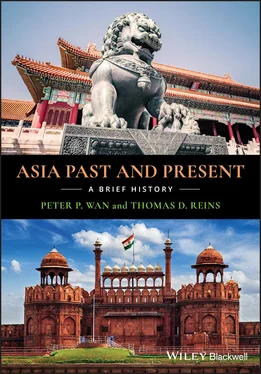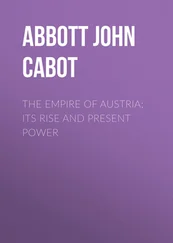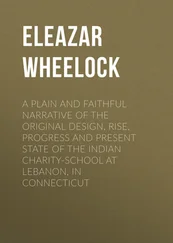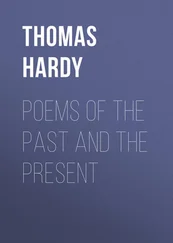Historians sometimes join the Qin and Han Dynasties in a continuum, calling it “China’s First Empire.” There is good reason for doing so: The Qin Dynasty initiated an unprecedented form of centralized bureaucratic government, but was unable to sustain it. The successor Han Dynasty improved on the Qin prototype, making it not only powerful but also sustainable. All succeeding dynasties in the next 20 centuries would adopt the amalgam of the Qin and Han models of imperial government.
The Founding of China’s First Empire: The Qin Dynasty (221–207 BCE)
The State of Qin produced one of the “Seven Overlords” fighting for hegemony during the Warring States period but it was weak, backward, and geographically on the fringe of “China Proper.” Its king, however, made it a viable contender after he employed Legalist Shang Yang as his advisor and imposed draconian reforms. His descendant, the future Qin Shihuang, continued to carry out bold and drastic Legalist reforms with the assistance of his prime minister Li Si (284–208 BCE) until he had turned Qin into a model of “rich country, strong army.” In 10 years of continuous wars, he defeated the other six overlords and unified all of China Proper for the first time in China’s history.
Shang Yang(390–338 BCE) was a Legalist who believed that it is agriculture and war that make a nation rich and strong. As advisor to the king of Qin, he carried out reforms to achieve that goal. He rewarded peasants with exemption from labor service for increasing their crop yields and bringing new lands under cultivation, and he abolished aristocrats’ inherited privileges and ranked men according to their contribution in war. These reforms naturally incurred the hatred of the old‐guard aristocrats. When the old king died, they had Shang Yang executed by quartering: His limbs and neck were tied to five horses, and drawn until his body was torn to pieces.
Timeline: Qin and Han Dynasties and the Era of Division, 221 BCE–581 CE
| 221–207 BCE |
Qin Dynasty. |
| 390–338 BCE |
Shang Yang: Legalist prime minister to the king of Qin before unification under Qin Shihuang |
| 284–208 BCE |
Li Si: Legalist prime minister under Qin Shihuang |
| 259–210 BCE |
Ying Zheng, who becomes Qin Shihuang in 221 BCE as he unifies China, constructs the Great Wall, and gives China its name from the name of the State of Qin |
| 207 BCE–220 CE |
Han Dynasty: embraces the Qin administrative system but tempers its tyrannical methods by adopting Confucian moral principles, creates the imperial examination system for bureaucratic civil service applicants, and gives the Chinese people their name, Han Ren, or Han people (i.e., Chinese people) |
| 256–195 BCE |
Commoner Liu Bang becomes Han Gaozu, the founding emperor of the Western or Former Han Dynasty at Chang’an/Xian |
| 179–104 BCE |
Thinker Dong Zhongshu revises classical Confucianism to enhance the status of the emperor; Confucianism becomes the official ideology of dynastic China |
| 156–87 BCE |
Liu Che (aka Han Wudi, or the Martial Emperor) launches successive wars against China’s neighboring nomadic tribes |
| 145–86 BCE |
Sima Qian, founder of China’s traditional historiography and author of Records of the Grand Historian |
| 81 BCE |
Salt and Iron Debates discuss the role of government in the economy |
| 9–23 CE |
Xi Dynasty under reformer Wang Mang briefly supplants Han Dynasty |
| 25–220 |
Eastern or Later Han Dynasty rules from Luoyang |
| 220–581 |
Period of Disunity begins after the fall of the Han Dynasty |
| 220–265 |
Three Kingdoms period |
| 265–317 |
Western Jin |
| 265–420 |
Eastern Jin |
| 317–581 |
Northern and Southern Dynasties |
| 581–589 |
Reunification of China under the Sui Dynasty |
As the supreme ruler of the country, he created a brand‐new title for himself—Qin Shi Huangdi, which means “The First Emperor of the Qin Dynasty.” The implication of the title was that his descendants would rule from generation to generation until eternity. He also created an unprecedented form of government: It centralized all power in the hands of one man—the emperor. Earlier, the Zhou “Son of Heaven” had direct control only of his own domain, while local lords enjoyed autonomy within their domains. But Qin Shihuang set up a centralized government bureaucracy that reached from the imperial court down to the county level, staffed it with officials he appointed and dismissed at his pleasure, and made laws that they enforced across the land. For the first time in its history, China had one ruler who exercised personal, direct, and total control over the entire population and territory. He had ended feudalism in its classical sense. The totalitarian bureaucratic state of empire was in; the semiautonomous feudal state was out.
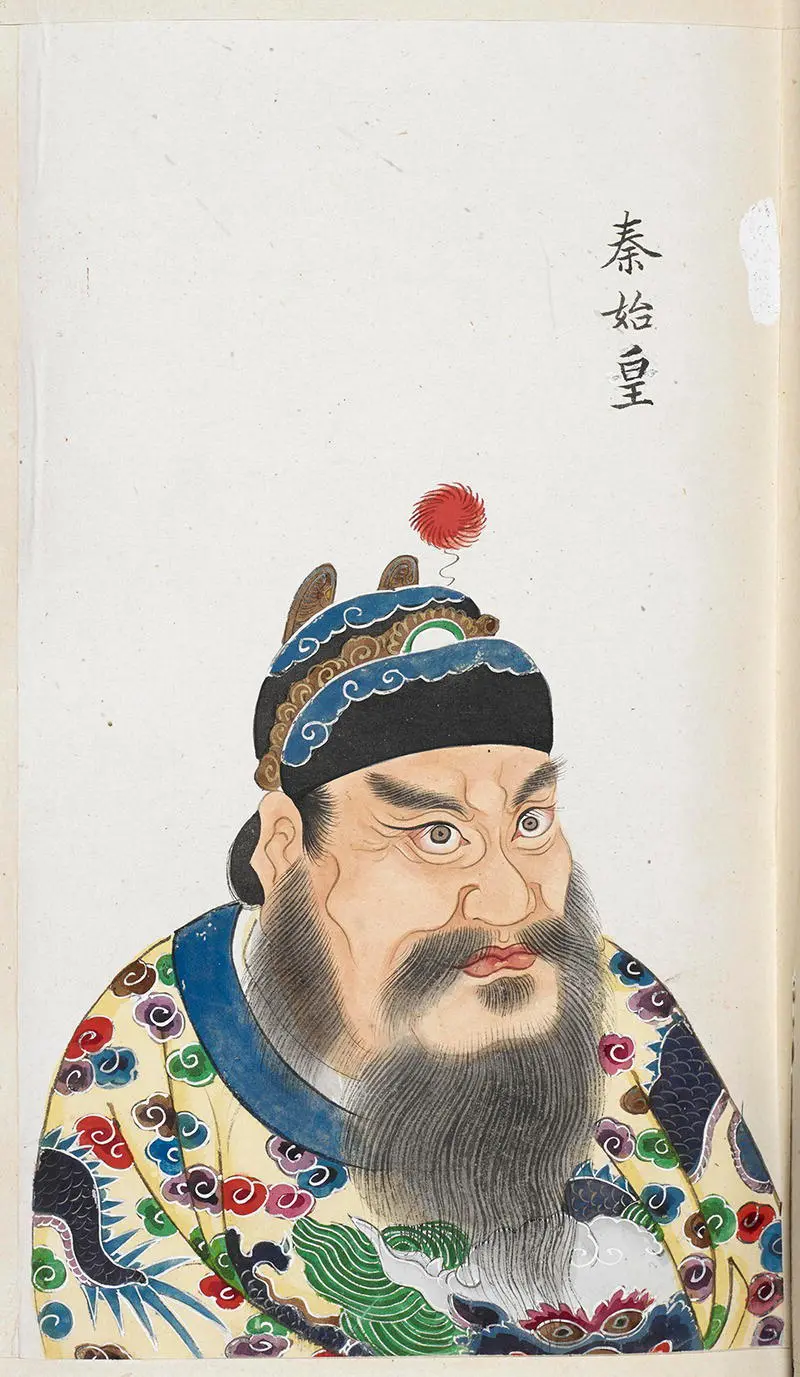
Qin Shi Huangdi (259–210 BCE).
Source: Album / Alamy Stock Photo.
A wealthy and influential merchant class emerged from the agricultural and commercial revolutions of the Warring States period, and they began entering politics. Lu Buwei (?–235 BCE) was one of them, and he was deeply involved in Qin politics. When the Qin king died, Lu became regent to the 13‐year‐old boy king. The able and ambitious boy king grew up in Lu’s shadow, and felt disgraced. He banished Lu as soon as he was officially crowned at age 20. Lu, out of fear, committed suicide in exile.
The Qin Empire had started out as a mishmash of seven formerly independent states that each had its own set of standards. But the emperor needed uniformity to ensure the smooth operation of his state machine across the extent of the empire. So he made laws to establish nationwide standards for everything. His laws established standards for the measurement of length, weight, and volume. He imposed a single monetary system and a single style of character writing. He ordered the building of a network of roads that radiated outward from the capital to all corners of the empire, and conformed to one single standard of width. This enabled him to ride in his carriage on his numerous inspection tours to all parts of the country, to send his mounted messengers to deliver his orders to anyone anywhere, and to dispatch his troops to crush any rebellion.
Chinese history was plagued by perennial conflict between the Han Chinese and their non‐Han neighbors. The Han Chinese were an agricultural people. They had the propensity of expanding into neighboring territories, but as a sedentary people they were also vulnerable to sudden attack. Their non‐Han neighbors, on the other hand, were nomadic tribal people who were capable of launching lightning‐fast raids either to defend their territories or to loot and kill. The Xiongnu, who roamed the steppes of Mongolia and Russia to the north of China, were the most feared of the nomadic tribes. To put an end to this threat, Qin Shihuang dispatched a force of 300,000 troops to drive them farther north.
To keep the nomads out, he ordered the building of the Great Wall. It was a project of unprecedented scale. But his absolute power enabled him to muster the human and material resources of the entire nation to drive toward that single goal. The completed Great Wall ran across China’s northern frontier, providing vital protection for the Han farming populations against nomadic attack. It would be renovated and extended in future dynasties.
Читать дальше
